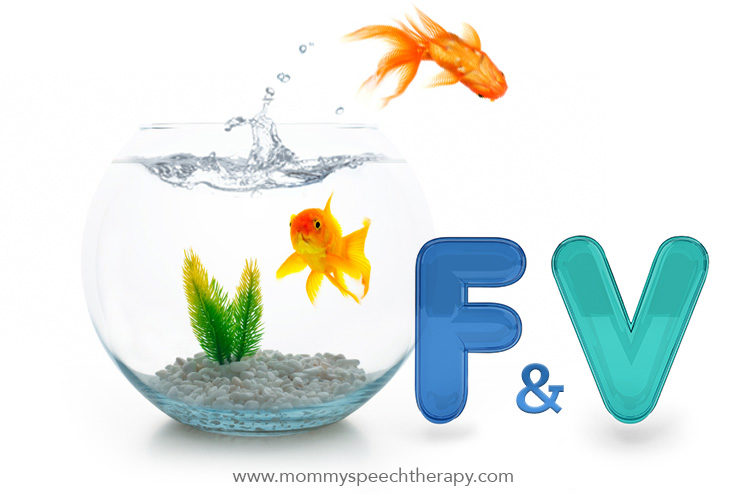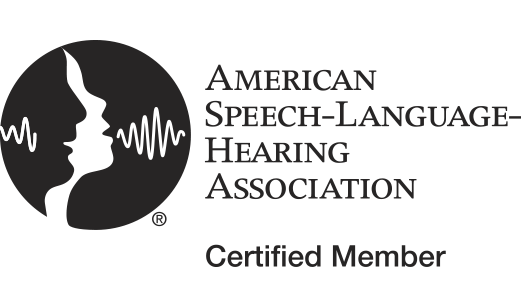Have you ever noticed how closely related the /f/ and /v/ sounds are? The /f/ sound is made by touching the upper teeth to the lower lip and then breathing out. The /v/ sound is made exactly the same way except for when you make the /v/ sound you “turn on” your voice. Knowing this helps us understand why when kids have trouble with the /f/ sound they most likely have trouble with the /v/ sound as well. That is why I have decided to write about how to teach both the /f/ and /v/ sounds in the same post.
One thing to keep in mind before we go any further is that the /f/ sound is typically mastered between the ages of 3 and 4, and the /v/ sound isn’t typically mastered until kids are about 5 or 6. So if your little toddler still says “pood” for “food” or “bery” for “very” don’t be too concerned. If, however, you would like to try teaching your children how to say these sounds correctly and they struggle with both the /f/ and /v/ sounds I would recommend starting with the /f/ sound first.
Before teaching any sound it is important to make sure the child is able to say that sound in isolation (all by itself). If the child cannot say the sound in isolation then we have to teach them how.
How to Teach the F Sound in Isolation:
The /f/ and /v/ sounds are fun sounds to teach because they are visually easy to see. The first thing I typically do when I teach these sounds is grab the mirror. After I model how to make the sound (by biting my lower lip and breathing out) I have the kids look in the mirror to make sure they are doing exactly what I am doing. It makes them feel so good when they see themselves doing it correctly!
Once they understand how to make the sound I tell them to think of the /f/ sound as the sound of an angry cat. Then we curl our fingers like the claws of a cat and practice making the sound together. I later use the “Angry Cat” as a cue (when we move onto words, sentences and stories) for the child to use his or her good /f/ sound.

How to Teach the V Sound in Isolation:
Like I mentioned above the only difference between the /f/ sound and the /v/ sound is the voice. So, if the child you are working with can say the /f/ sound, teaching the /v/ sound is easy. Simply tell them to say the /f/ sound and then “turn on” their voice for the /v/ sound. You may want to have them feel the vibrations on their throat or lower lip when making the sound. This will help them distinguish the difference between these sounds.
Once they can say the /v/ sound a fun way to practice it is to call it the “Revving engine” sound. Together pretend you are revving an engine while you take turns saying “vvvv, vvv, VVV.” Adding some toy cars makes it a lot of fun. Sometimes I use the sign language sign for driving a car as a cue later to help them remember to say their good /v/ sound when we start working in words, sentences or stories.
How to Teach the F and V Sounds in Syllables:
Once your child can say the /f/ and or /v/ sounds in isolation you are ready to put them into syllables. Think of syllables as a baby step that helps make the transition from isolation to words a little smoother. Practicing words in syllables can also help determine in which position of words (initial, medial or final) you should begin practicing the /f/ or /v/ sound.
To practice the sound in syllables simply add a vowel after the /f/ sound for the initial (beginning) position, before the /f/ sound for the final position, and before and after the /f/ sound for the medial (middle) position, being sure to practice the long and short form of each vowel.
My favorite way to practice initial /f/ syllables is to practice saying, “Fee, Fi, Fo, Fum (and with my own kids) I’m going to tickle your tummy, tum tum. We have a lot of giggles with this one as I chase them around the house! They especially love it when it’s their turn and they get to come after me. Yikes!
Some final /f/ syllables would be “aff, eff, if, off, and uff. Some medial /f/ syllables would be, “affu, effi, iffa, uffo, and offee. Do the same with the /v/ sound adding vowels to the sound for practice at the syllable level.
If your child is the most successful with the /f/ or /v/ sound in the initial position of syllables then begin by practicing the /f/ or /v/ sound in initial position of words. If your child has more success with the /f/ or /v/ sound in the final position of syllables begin by practicing the /f/ or /v/ sound in the final position of words and so on. Kids typically have an easier time with the initial or final syllables which is why I usually start with one of those.
How to Teach the F and a V Sounds in Words:
Once the /f/ and /v/ sounds are mastered in syllables and you have decided which position (initial, medial or final) you want to target you are ready to practice them in words. You can use the word cards I have created on the worksheets page to practice the /f/ and /v/ sounds. Once the sounds are said in words correctly (at least 80% of the time) you are ready to practice the /f/ and /v/ sounds in sentences.
How to Teach the F and V Sounds in Sentences:
Once your child can say the /f/ and /v/ sounds correctly in words practice them in sentences. My favorite way to practice sounds in sentences is with a “rotating sentence,” which is a lot like carrier phrase. In a rotating sentence only the target word changes while the sentence stays the same. For example, an initial /f/ rotating sentence is, “Feed the funny ________ .” When you rotate your practice words through it you get sentences like, “Feed the funny fox,” or “Feed the funny fish.”

This is an especially great way to practice sentences for young children who can’t read yet. They are able to memorize the sentence, or use visual cues to help them read it aloud. You are also able to maximize the production of your target sound when you use a sentence with two or three target words in it. You may find sentences for the different positions of the /f/ and /v/ sounds on the worksheets page.
How to Teach the F and V Sounds in Stories:
Once your child can say the /f/ and /v/ sounds with about 80% accuracy in sentences you are ready for stories. For my younger children I like to prepare a story for them to practice using the sound cards they have been practicing. You may also download the stories on the worksheets page. All the stories have picture prompts to assist our little ones in retelling the stories who may not quite be reading yet.
Older kids sometimes like to write their own stories using the target words they have been practicing. They usually come up with very creative stories that are very entertaining and fun! This is great because it encourages the child to participate and get creative.
After the child has mastered reading the story aloud with about 80% accuracy I have them retell me the story without reading it. This is just another baby step toward getting an accurate production of the target sound in conversation. Once they can do this I tell them they are ready to practice the sound in conversation. So here we go, onto conversation…
How to Teach the F and V Sounds in Conversation:
Now that you have taught the /f/ and /v/ sounds in isolation, syllables, words, sentences and stories you are finally ready to help the child you are working with transition these sounds into conversation. At this point in the process it is ok to correct an inaccurate production of these sounds in conversation, in fact I would encourage you to do so. Generalizing the sound from practicing them in words, sentences and stories to conversation can be the most difficult step. If you find that they are still making really frequent mistakes it’s perfectly ok to go back and work on the sound in sentences or stories again until they get it.
For more details on to how to carry the /f/ and /v/ sounds through this process, I would suggest reading my post entitled “The Process of Articulation Therapy” . You may download and use the /f/ and /v/ sound worksheets on the worksheets page for practice.
If you have an iPad, you might also be interested in Articulation Station, an app I created based on the articulation process outlined in this post. It has all the flashcards, sentences and stories in 6 different interactive activities! The free demo comes with the P sound to try and you have the option of purchasing only the individual sounds you need from within the app. You can watch video tutorials and get more information about Articulation Station on my post “Articulation Station is on the App Store!”
I hope as you sit down to practice these sounds with your kids you will have a blast as you watch the sweet smile of success spread across their adorable little faces and remember the superstar mom (or dad) that you are!






13 Comments